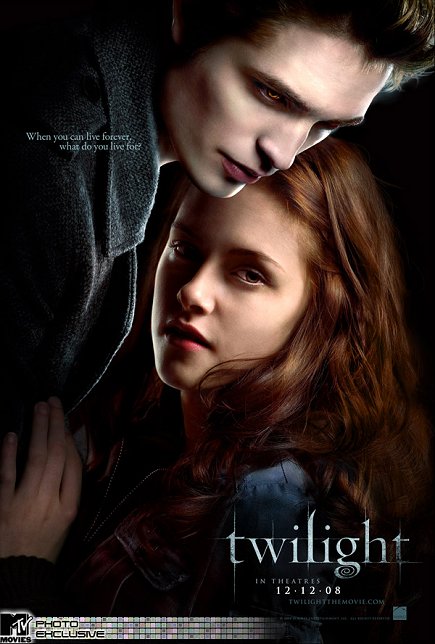 “Twilight” was a guaranteed hit. The adaptation of Stephenie Meyer’s immensely popular book about forbidden love between a vampire and a human had a huge built-in audience that was going to come out no matter what. Here was an opportunity to try to make something with an edge that could still make money. Leave it to Hollywood to not take the risk.
“Twilight” was a guaranteed hit. The adaptation of Stephenie Meyer’s immensely popular book about forbidden love between a vampire and a human had a huge built-in audience that was going to come out no matter what. Here was an opportunity to try to make something with an edge that could still make money. Leave it to Hollywood to not take the risk.As a film, “Twilight” isn’t awful, but for large portions it is completely underwhelming and lifeless. There is a dull visual sameness throughout. Nearly every scene has the grayish blue of a perpetual twilight, which is probably the point, but is hardly compelling to look at.
The first half of the film comes dangerously close to being boring with repeated scenes of new girl in town Bella (Kristen Stewart, “In The Land of Women”) and the mysterious Edward (Robert Pattinson) exchanging lustful looks. There is a scene early on that is unintentionally laugh-out-loud funny.
It is not a surprise that Edward is a vampire, but the film acts like it is and takes far too long getting Bella to that realization. Just in case the audience wasn’t paying attention, director Catherine Hardwicke gives brief flashbacks to all the evidence: He’s fast, he’s strong and he has cold skin. It is an insult to the intelligence of the audience.
Many critics have used phrases such as “but I am not the demographic” when describing the film. This is a cop-out because if the film were better made it could transcend its target audience of non-discerning teen girls and find a broader appeal. Meyer’s book series has a large adult readership, in addition to its teen one, that is being ignored
There is so much potential that the film only hints at. These are non-traditional vampires. This story features no stakes through the heart, holy water, garlic, coffins or crosses. The vampires can walk in the daylight, although they avoid direct sunlight because it reveals their identity in an unusual way.
At its core, there is an intriguing, largely unexplored, concept of a vampire family who has made a decision to feed only on animal blood. Although they aren’t related by blood, so to speak, Edward is part of a large family with many brothers and sisters. These characters are briefly introduced and seem likable and interesting, but aside from a dynamic baseball game — the best scene in the film — we don’t spend any quality time with them.
More time should have been allowed for interaction between Bella and Edward with his family. If less time had been spent with brooding glares in parking lots and classrooms, this could have been possible.
It doesn’t help that the film ends with a chase and fight involving a rival vampire (Cam Gigandet) who hungers for Bella. This conclusion is meant to show that Bella is now part of Edward’s “family,” but since so little time was given to developing that aspect of the film the chase feels more obligatory than a true extension of the story.
Overall, the film is certainly watchable, but it should be more than just that. There are isolated lines of wit that suggest to what could’ve been. There is also some nice chemistry between Stewart and Taylor Lautner, as one of Bella’s childhood friends. The actors are fine, but Stewart and Pattinson aren’t asked do much more than look beautiful. Many teen girls will pay the price of admission just to swoon over Pattinson.
Ultimately, the real disappointment here is director Hardwicke, whose first film “Thirteen” chronicled the loss of innocence of a young girl who succumbed to a lifestyle of sex and drugs. That film had an authenticity because Hardwicke co-scripted the film with the then 14-year old Nikki Reed — who plays Rosalie in “Twilight.” Perhaps Reed should’ve given screenwriter Melissa Rosenberg’s largely flat adaptation of “Twilight” a once over.
“Twilight” plays it safe when it could’ve been provocative and explored complex themes. Forgive me, but it has to be said: “Twilight” lacks bite.
 “Quantum of Solace,” the 22nd James Bond film, is the first direct sequel in the franchise’s 46 years. It marks a different direction for the series as it moves away from formula to try to create a new Bond universe.
“Quantum of Solace,” the 22nd James Bond film, is the first direct sequel in the franchise’s 46 years. It marks a different direction for the series as it moves away from formula to try to create a new Bond universe. Today the 22nd official James Bond movie, “Quantum of Solace” arrives in theaters. I am not among the privileged elite who have already seen it, so for now I want to take a look back at agent 007.
Today the 22nd official James Bond movie, “Quantum of Solace” arrives in theaters. I am not among the privileged elite who have already seen it, so for now I want to take a look back at agent 007.  “Zack and Miri Make a Porno” has caused a bit of stir with just its name. Around the country some newspapers and advertisers have refused to run the full title and a multiplex chain in Utah banned the film.
“Zack and Miri Make a Porno” has caused a bit of stir with just its name. Around the country some newspapers and advertisers have refused to run the full title and a multiplex chain in Utah banned the film. 